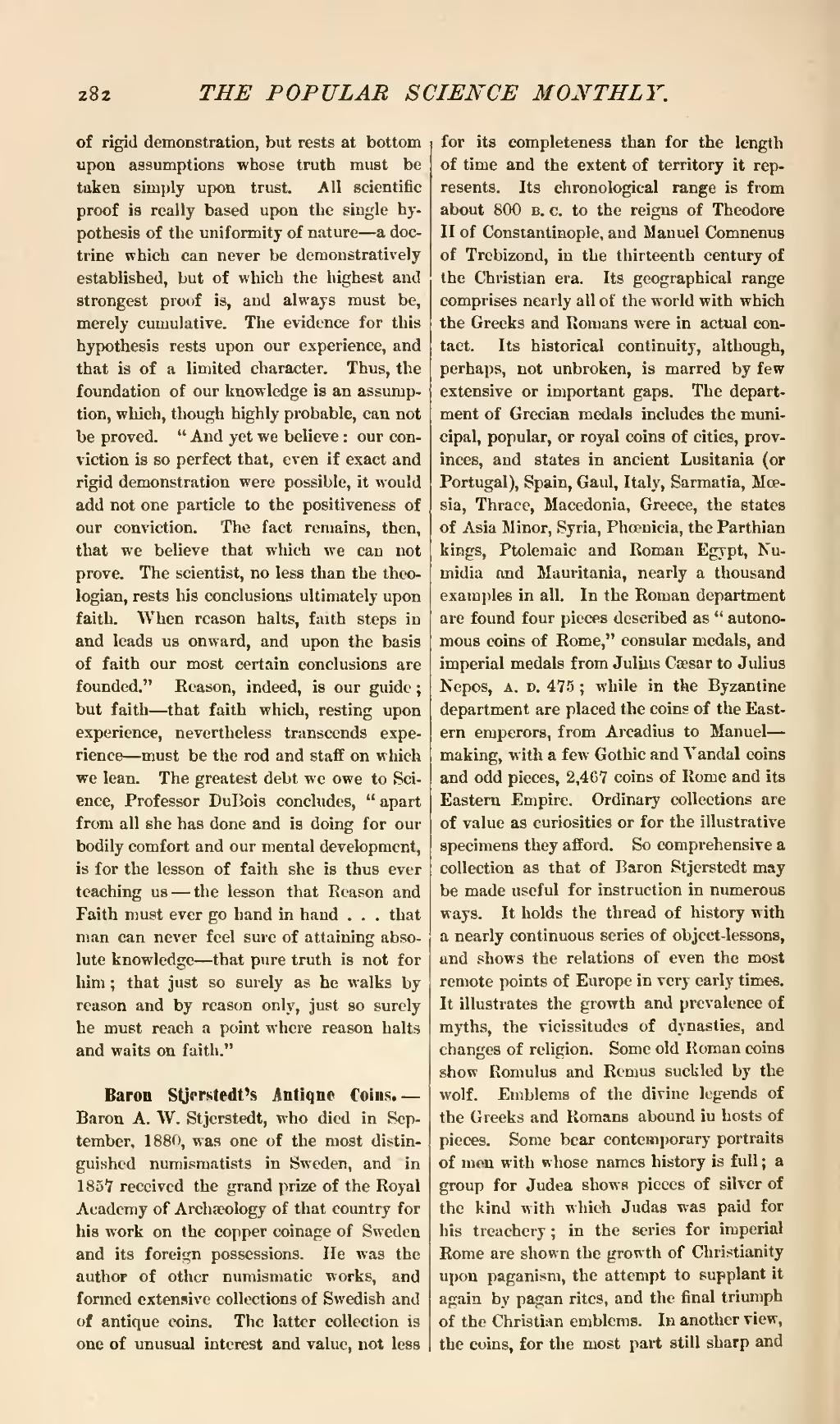of rigid demonstration, but rests at bottom upon assumptions whose truth must be taken simply upon trust. All scientific proof is really based upon the single hypothesis of the uniformity of nature—a doctrine which can never be demonstratively established, but of which the highest and strongest proof is, and always must be, merely cumulative. The evidence for this hypothesis rests upon our experience, and that is of a limited character. Thus, the foundation of our knowledge is an assumption, which, though highly probable, can not be proved. "And yet we believe: our conviction is so perfect that, even if exact and rigid demonstration were possible, it would add not one particle to the positiveness of our conviction. The fact remains, then, that we believe that which we can not prove. The scientist, no less than the theologian, rests his conclusions ultimately upon faith. When reason halts, faith steps in and leads us onward, and upon the basis of faith our most certain conclusions are founded." Reason, indeed, is our guide; but faith—that faith which, resting upon experience, nevertheless transcends experience—must be the rod and staff on which we lean. The greatest debt we owe to Science, Professor DuBois concludes, "apart from all she has done and is doing for our bodily comfort and our mental development, is for the lesson of faith she is thus ever teaching us—the lesson that Reason and Faith must ever go hand in hand. . . that man can never feel sure of attaining absolute knowledge—that pure truth is not for him; that just so surely as he walks by reason and by reason only, just so surely he must reach a point where reason halts and waits on faith."
Baron Stjerstedt's Antique Coins.—Baron A. W. Stjerstedt, who died in September, 1880, was one of the most distinguished numismatists in Sweden, and in 1857 received the grand prize of the Royal Academy of Archæology of that country for his work on the copper coinage of Sweden and its foreign possessions. lie was the author of other numismatic works, and formed extensive collections of Swedish and of antique coins. The latter collection is one of unusual interest and value, not less for its completeness than for the length of time and the extent of territory it represents. Its chronological range is from about 800 b. c. to the reigns of Theodore II of Constantinople, and Manuel Comnenus of Trebizond, in the thirteenth century of the Christian era. Its geographical range comprises nearly all of the world with which the Greeks and Romans were in actual contact. Its historical continuity, although, perhaps, not unbroken, is marred by few extensive or important gaps. The department of Grecian medals includes the municipal, popular, or royal coins of cities, provinces, and states in ancient Lusitania (or Portugal), Spain, Gaul, Italy, Sarmatia, Moesia, Thrace, Macedonia, Greece, the states of Asia Minor, Syria, Phoenicia, the Parthian kings, Ptolemaic and Roman Egypt, Numidia and Mauritania, nearly a thousand examples in all. In the Roman department are found four pieces described as "autonomous coins of Rome," consular medals, and imperial medals from Julius Cæsar to Julius Nepos, a. d. 475; while in the Byzantine department are placed the coins of the Eastern emperors, from Arcadius to Manuel—making, with a few Gothic and Vandal coins and odd pieces, 2,467 coins of Rome and its Eastern Empire. Ordinary collections are of value as curiosities or for the illustrative specimens they afford. So comprehensive a collection as that of Baron Stjerstedt may be made useful for instruction in numerous ways. It holds the thread of history with a nearly continuous series of object-lessons, and shows the relations of even the most remote points of Europe in very early times. It illustrates the growth and prevalence of myths, the vicissitudes of dynasties, and changes of religion. Some old Roman coins show Romulus and Remus suckled by the wolf. Emblems of the divine legends of the Greeks and Romans abound in hosts of pieces. Some bear contemporary portraits of men with whose names history is full; a group for Judea shows pieces of silver of the kind with which Judas was paid for his treachery; in the series for imperial Rome are shown the growth of Christianity upon paganism, the attempt to supplant it again by pagan rites, and the final triumph of the Christian emblems. In another view, the coins, for the most part still sharp and
